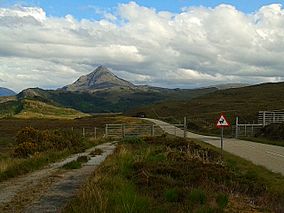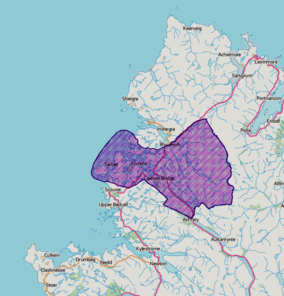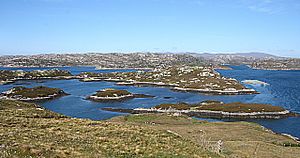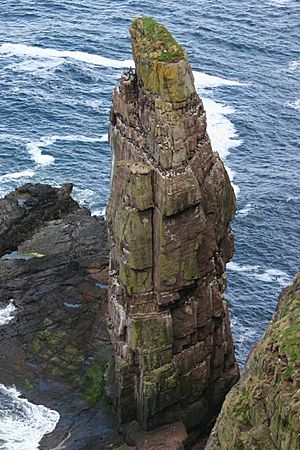North West Sutherland National Scenic Area facts for kids
Quick facts for kids North West Sutherland National Scenic Area |
|
|---|---|

Ben Stack seen from the A838 road
|
|

Location and extent of the North West Sutherland NSA.
|
|
| Location | Sutherland, Highland, Scotland |
| Area | 266 km2 (103 sq mi) |
| Established | 1981 |
| Governing body | NatureScot |
North West Sutherland is a special protected area in the Scottish Highlands of Scotland. It's called a National Scenic Area (NSA) because of its amazing mountains and beautiful coastline. This area covers famous mountains like Foinaven, Arkle, and Ben Stack. It also includes the stunning coastal views around Loch Laxford and Handa Island.
Scotland has 40 of these National Scenic Areas. They are chosen to protect places with truly outstanding scenery. This helps make sure that new buildings or developments don't spoil their natural beauty. The North West Sutherland NSA is quite large, covering about 26,565 hectares. Most of this is land, but a good part is also sea, including the waters near the coast.
While these areas are mainly picked for their scenery, they often have other special qualities too. This can include interesting history, unique rocks, or important wildlife. Because of this, North West Sutherland also has other special protections for its nature. In the Gaelic language, this area is known as Ceathramh Garb, which means the "Rough Quarter."
Why North West Sutherland Became a Special Area
After the Second World War, people in Scotland started thinking about how to protect their beautiful landscapes. A group was set up in 1945 to look into this. They suggested that five areas should get special protection.
Later, in 1978, another review happened. This time, the remote northwestern parts of Sutherland were also identified as very special. They decided this area needed protection because of its unique and wild beauty.
So, in 1981, the National Scenic Area (NSA) plan was created. This new plan included the North West Sutherland area, based on the 1978 ideas. The boundaries of the area are still the same as they were first drawn.
Even though NSAs have special protection, they don't have their own dedicated teams like big national parks do. Instead, local councils, like the Highland Council, help manage these areas.
Amazing Mountains and Coastline
The North West Sutherland area is famous for its dramatic landscape. The mountains here, like Foinaven, Arkle, and Ben Stack, are made of very old and tough rocks.
- Ben Stack (721 meters high) looks like a neat cone.
- Arkle (787 meters high) is shaped like a whale's back.
- Foinaven (909 meters high) is a long, broken slab with several peaks.
The sides of Arkle and Foinaven are covered in white, rocky slopes. These are made of a rock called quartzite. It looks like a stark, rocky desert. The land around these mountains is also very rugged, with many small hills and lakes. This makes the whole area feel wild and untouched.
Loch Laxford is a sea loch that fits perfectly with the mountains. Its coastline is very jagged and rocky. Unlike some other lochs, it doesn't have many trees along its edges. But it does have some sheltered beaches. From these beaches, you can see Handa Island. This island has tall sandstone cliffs and is home to many seabirds.
Most of this area is wild and uninhabited. There are only a few small villages, called crofting townships, along the coast. Examples include Fanagmore and Foindle. In the inland areas, you might find isolated lodges used for hunting. The ancient rocks of the area are very clear to see everywhere. The soil is thin, so you won't find many forests here.
Protecting Wildlife and Nature
The North West Sutherland National Scenic Area is very important for wildlife. It has several special designations to protect its plants and animals. These include two Special Protection Areas (SPAs) and two Special Areas of Conservation (SACs).
- Handa Island is an SPA because it's a vital place for many seabirds to breed. These include fulmars, great skuas, guillemots, kittiwakes, and razorbills. The Scottish Wildlife Trust helps manage this island.
- The mountains around Foinaven and Arkle are also an SPA. This is because a group of golden eagles lives and breeds there.
- The Foinaven area is also a SAC. It has several important natural habitats. This area is also home to freshwater pearl mussels and otters.
- Loch Laxford is a SAC because of its reefs and calm, shallow bays. The many reefs and islands help keep the water calm. This loch has the largest area of sheltered coastline in the far northwest of Scotland.



